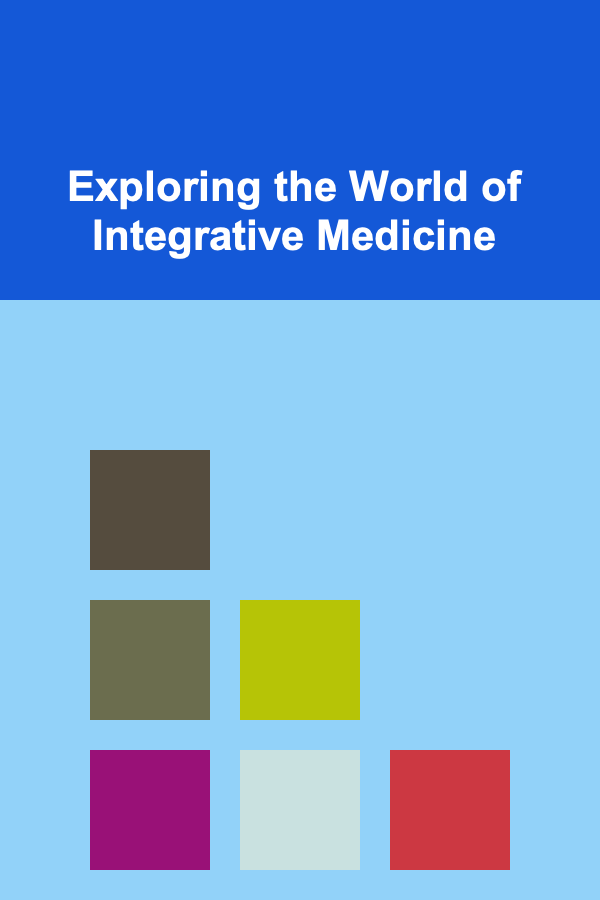
Exploring the World of Integrative Medicine
ebook include PDF & Audio bundle (Micro Guide)
$12.99$6.99
Limited Time Offer! Order within the next:

Introduction: Bridging the Gap Between Conventional and Complementary Therapies
Integrative medicine represents a paradigm shift in healthcare, moving away from a siloed approach that often separates conventional medical practices from complementary and alternative therapies. Instead, it embraces a holistic philosophy that emphasizes the interconnectedness of the mind, body, and spirit, seeking to address the root causes of illness and promote overall well-being. This comprehensive approach combines the best aspects of conventional medicine with evidence-based complementary therapies to create a personalized treatment plan tailored to the individual's unique needs and circumstances.
The rise of integrative medicine reflects a growing dissatisfaction with purely symptom-based treatment models and a desire for more patient-centered care. Many individuals are seeking ways to actively participate in their own healing journey, exploring therapies that address not only their physical symptoms but also their emotional, mental, and spiritual well-being. This quest for a more holistic approach has fueled the demand for integrative medicine practices and practitioners.
However, navigating the world of integrative medicine can be challenging. The field encompasses a vast array of therapies, ranging from well-established practices like acupuncture and chiropractic to newer and less-studied modalities. It is crucial to approach integrative medicine with a discerning mind, seeking out qualified practitioners, evaluating the evidence supporting different therapies, and understanding the potential risks and benefits involved. This article aims to provide a comprehensive guide to exploring the world of integrative medicine, offering insights into its core principles, common modalities, how to find qualified practitioners, and how to critically evaluate the information you encounter.
Core Principles of Integrative Medicine
Integrative medicine is guided by a set of core principles that differentiate it from conventional medicine and other alternative approaches. Understanding these principles is essential for grasping the essence of integrative medicine and its potential benefits.
- Patient-Centered Care: Integrative medicine places the patient at the center of the healing process. Treatment plans are tailored to the individual's unique needs, preferences, and values, rather than solely focusing on the disease or condition. This involves active listening, shared decision-making, and a collaborative approach between the practitioner and the patient. It acknowledges that each patient has a unique history, genetic makeup, lifestyle, and social context that influences their health and well-being.
- Whole-Person Approach: Integrative medicine recognizes the interconnectedness of the mind, body, and spirit. It addresses all aspects of a person's being, including physical, emotional, mental, social, and spiritual factors. This holistic perspective acknowledges that illness can stem from imbalances in any of these areas and that healing requires addressing all contributing factors. For example, chronic pain may be influenced by emotional stress, sleep deprivation, poor nutrition, and lack of social support, and an integrative approach would address each of these factors.
- Emphasis on Prevention and Wellness: Integrative medicine prioritizes prevention and wellness, aiming to promote health and prevent disease before it occurs. This involves educating patients about healthy lifestyle choices, such as nutrition, exercise, stress management, and sleep hygiene. It also emphasizes the importance of building resilience, enhancing immune function, and fostering a sense of purpose and meaning in life. Regular check-ups and screenings are combined with proactive strategies to optimize health and prevent chronic diseases.
- Combining Conventional and Complementary Therapies: Integrative medicine integrates the best aspects of conventional medicine with evidence-based complementary therapies. This means utilizing conventional medical treatments when appropriate, such as medications and surgery, while also incorporating complementary therapies to address underlying imbalances, reduce side effects, and enhance the body's natural healing abilities. The goal is to create a synergistic effect, where the combined therapies are more effective than either approach alone.
- Evidence-Informed Practice: Integrative medicine emphasizes the importance of evidence-based practice, meaning that treatment decisions are guided by the best available scientific evidence. This involves critically evaluating research studies, considering the quality of the evidence, and taking into account clinical experience and patient preferences. While some complementary therapies may have limited evidence due to funding constraints or methodological challenges, integrative practitioners strive to use therapies that have been shown to be safe and effective. They also remain open to exploring promising new therapies as research emerges.
- Focus on the Therapeutic Relationship: The therapeutic relationship between the practitioner and the patient is considered a crucial element of the healing process. Integrative practitioners strive to create a supportive, trusting, and collaborative environment where patients feel empowered to actively participate in their care. This involves active listening, empathy, and a commitment to understanding the patient's perspective. The practitioner acts as a guide and facilitator, helping the patient to identify their goals, explore different treatment options, and develop a personalized plan for healing.
- Promoting Self-Healing: Integrative medicine recognizes the body's innate capacity to heal itself. The goal of treatment is to stimulate the body's natural healing mechanisms and to create an environment that supports optimal health and well-being. This may involve using therapies that reduce inflammation, enhance immune function, balance hormones, or promote relaxation and stress reduction. It also emphasizes the importance of empowering patients to take responsibility for their own health and to actively participate in their healing journey.
Common Modalities in Integrative Medicine
Integrative medicine encompasses a wide range of therapies, some of which are more commonly used and well-established than others. Here are some of the most prevalent modalities found in integrative medicine practices:
- Acupuncture: A traditional Chinese medicine technique that involves inserting thin needles into specific points on the body to stimulate energy flow and promote healing. Acupuncture is often used to treat pain, nausea, and other conditions. Research suggests it can be effective for certain types of pain, such as back pain and osteoarthritis.
- Mind-Body Therapies: This category includes a variety of techniques that focus on the interaction between the mind and body, such as meditation, yoga, tai chi, guided imagery, and biofeedback. These therapies can help reduce stress, improve mood, enhance relaxation, and promote overall well-being. They are often used to manage chronic pain, anxiety, depression, and other conditions.
- Nutritional Therapy: Focuses on the role of diet and nutrition in health and disease. Integrative practitioners may recommend dietary changes, nutritional supplements, and functional foods to address nutrient deficiencies, optimize digestion, reduce inflammation, and support overall health. This may include personalized meal plans, elimination diets, and strategies for managing food sensitivities and allergies.
- Herbal Medicine: Uses plants and plant extracts to treat illness and promote health. Herbal medicine has a long history of use in many cultures and is increasingly being studied for its potential therapeutic benefits. It's crucial to consult with a qualified herbalist, as some herbs can interact with medications or have potential side effects.
- Chiropractic: A healthcare profession that focuses on the diagnosis, treatment, and prevention of musculoskeletal disorders, particularly those affecting the spine. Chiropractors use manual adjustments to restore proper alignment and function to the spine and other joints, which can help relieve pain, improve mobility, and enhance nervous system function.
- Massage Therapy: Involves manipulating the soft tissues of the body to relieve pain, reduce stress, improve circulation, and promote relaxation. Different types of massage therapy exist, such as Swedish massage, deep tissue massage, and sports massage, each with its own specific techniques and benefits.
- Osteopathic Medicine (OMT): Osteopathic physicians (DOs) are trained in conventional medicine but also receive additional training in osteopathic manipulative treatment (OMT). OMT involves using hands-on techniques to diagnose and treat musculoskeletal problems and to improve overall health.
- Naturopathic Medicine: Naturopathic doctors (NDs) are trained in a holistic approach to healthcare that emphasizes natural therapies, such as nutrition, herbal medicine, homeopathy, and lifestyle counseling. NDs aim to identify and address the root causes of illness and to support the body's natural healing abilities.
- Functional Medicine: A systems-oriented approach that focuses on identifying and addressing the underlying causes of disease. Functional medicine practitioners use a variety of diagnostic tests and treatment strategies to personalize care and to restore optimal health and function. They often address areas such as gut health, hormonal imbalances, and detoxification.
- Ayurveda: An ancient Indian system of medicine that emphasizes the balance of mind, body, and spirit. Ayurvedic practitioners use a variety of therapies, such as diet, herbal medicine, yoga, and meditation, to promote health and prevent disease.
Finding Qualified Integrative Medicine Practitioners
One of the most important steps in exploring integrative medicine is finding qualified practitioners who are properly trained and experienced. Not all healthcare providers who claim to practice integrative medicine have the same level of expertise or adherence to the core principles of the field. Here are some tips for finding qualified integrative medicine practitioners:
- Check Credentials and Licensing: Ensure that the practitioner is licensed and certified in their respective field. This may involve checking with state licensing boards or professional organizations. For example, acupuncturists should be licensed by the state, and chiropractors should be licensed by their state chiropractic board. Naturopathic doctors should be licensed in states that regulate naturopathic medicine.
- Look for Specialized Training in Integrative Medicine: Many practitioners have completed additional training in integrative medicine beyond their initial medical education. Look for certifications or fellowships in integrative medicine from reputable organizations, such as the Academy of Integrative Health & Medicine (AIHM) or the American Board of Integrative Medicine (ABOIM).
- Ask About Experience: Inquire about the practitioner's experience in treating your specific condition. Ask how many years they have been practicing integrative medicine and how many patients they have treated with similar health concerns.
- Seek Referrals: Ask your primary care physician or other healthcare providers for referrals to integrative medicine practitioners. You can also ask friends, family, or colleagues for recommendations.
- Read Online Reviews and Testimonials: Check online review sites and read testimonials from other patients to get a sense of the practitioner's reputation and patient satisfaction.
- Schedule a Consultation: Schedule a consultation with the practitioner to discuss your health concerns, treatment goals, and approach to care. This is an opportunity to ask questions, assess their communication style, and determine if they are a good fit for your needs.
- Inquire About Their Philosophy and Approach: Ask the practitioner about their approach to integrative medicine and how they integrate conventional and complementary therapies. Ensure that they align with your values and preferences. Do they emphasize a patient-centered approach? How do they assess the whole person? How do they incorporate evidence-based practices?
- Consider Their Communication Style: Effective communication is essential for a successful therapeutic relationship. Choose a practitioner who is a good listener, who explains things clearly, and who is willing to answer your questions.
- Verify Board Certifications: If a practitioner claims to be board-certified in a particular specialty, verify their certification through the relevant medical board's website.
Important Considerations: Be wary of practitioners who make unrealistic claims or promise miracle cures. Integrative medicine is not a substitute for conventional medical care, and it should not be used to delay or avoid necessary medical treatment. It's crucial to maintain open communication with all of your healthcare providers and to inform them about any complementary therapies you are using.
Evaluating Evidence in Integrative Medicine
A critical aspect of exploring integrative medicine is the ability to evaluate the evidence supporting different therapies. While conventional medicine relies heavily on randomized controlled trials (RCTs) as the gold standard for evidence, many complementary therapies have limited evidence due to funding constraints, methodological challenges, and the complexity of studying whole-person approaches. However, this doesn't necessarily mean that these therapies are ineffective; it simply means that more research is needed.
Here are some tips for evaluating evidence in integrative medicine:
- Understand Different Types of Evidence: Be aware of the different types of evidence, including randomized controlled trials (RCTs), observational studies, systematic reviews, meta-analyses, and expert opinions. RCTs are generally considered the strongest form of evidence, but observational studies and expert opinions can also provide valuable insights.
- Consider the Source of Information: Evaluate the credibility of the source of information. Look for information from reputable organizations, such as medical journals, government agencies, and academic institutions. Be wary of information from websites that promote specific products or therapies without providing supporting evidence.
- Look for Systematic Reviews and Meta-Analyses: Systematic reviews and meta-analyses summarize the findings of multiple studies on a particular topic, providing a more comprehensive overview of the evidence. These types of reviews can be helpful for evaluating the overall effectiveness of a therapy.
- Critically Evaluate Research Studies: When evaluating research studies, consider the study design, sample size, control group, and outcome measures. Look for studies that are well-designed, have a large sample size, use a control group, and measure clinically relevant outcomes.
- Be Aware of Bias: Be aware of potential sources of bias, such as funding bias, publication bias, and selection bias. Funding bias occurs when research is funded by a company that stands to benefit from the results. Publication bias occurs when studies with positive results are more likely to be published than studies with negative results. Selection bias occurs when the participants in a study are not representative of the population as a whole.
- Consider Clinical Experience and Patient Preferences: While evidence is important, it is not the only factor to consider when making treatment decisions. Clinical experience and patient preferences are also important considerations. Integrative practitioners often rely on their clinical experience to guide treatment decisions and to tailor therapies to the individual needs of their patients.
- Consult with Qualified Healthcare Professionals: If you are unsure about the evidence supporting a particular therapy, consult with a qualified healthcare professional who can help you evaluate the evidence and make informed decisions.
Resources for Evaluating Evidence:
- National Center for Complementary and Integrative Health (NCCIH): Provides information on the safety and effectiveness of various complementary and integrative health practices.
- Cochrane Library: A collection of systematic reviews of healthcare interventions.
- PubMed: A database of biomedical literature.
Potential Risks and Benefits of Integrative Medicine
Like any medical treatment, integrative medicine has potential risks and benefits. It is important to be aware of these risks and benefits before starting any new therapy. While the goal of integrative medicine is to combine safe and effective therapies, it's crucial to be informed and proactive.
Potential Benefits:
- Reduced Symptoms: Integrative medicine can help reduce symptoms of a variety of conditions, such as pain, fatigue, anxiety, and depression.
- Improved Quality of Life: Integrative medicine can improve quality of life by enhancing physical, emotional, and mental well-being.
- Reduced Side Effects: Integrative medicine can help reduce the side effects of conventional medical treatments.
- Enhanced Self-Efficacy: Integrative medicine can empower patients to take responsibility for their own health and to actively participate in their healing journey.
- Prevention of Disease: Integrative medicine can help prevent disease by promoting healthy lifestyle choices and addressing underlying imbalances.
- Complementary Support: Integrative therapies can offer support for patients undergoing conventional treatments like chemotherapy, helping manage side effects and improve overall tolerance.
Potential Risks:
- Lack of Evidence: Some complementary therapies have limited evidence supporting their effectiveness.
- Adverse Effects: Some complementary therapies can cause adverse effects, such as allergic reactions, drug interactions, or other complications.
- Interactions with Medications: Some complementary therapies can interact with medications, potentially reducing their effectiveness or increasing the risk of side effects.
- Cost: Some integrative medicine therapies are not covered by insurance and can be expensive.
- Unqualified Practitioners: Working with unqualified practitioners can lead to ineffective or even harmful treatments.
- Delayed or Avoided Medical Treatment: Using integrative medicine as a substitute for conventional medical care can delay or avoid necessary medical treatment. It's essential to ensure integrative therapies are used in conjunction with, not instead of, appropriate conventional care.
Minimizing Risks:
- Choose Qualified Practitioners: Work with qualified practitioners who are properly trained and experienced.
- Inform Your Healthcare Providers: Inform all of your healthcare providers about any complementary therapies you are using.
- Research Therapies Thoroughly: Research therapies thoroughly and understand the potential risks and benefits.
- Start Slowly: Start slowly and monitor your body's response to new therapies.
- Listen to Your Body: Pay attention to your body and report any adverse effects to your healthcare provider.
- Maintain Open Communication: Maintain open communication with your healthcare providers and ask questions if you have any concerns.
Integrating Integrative Medicine into Your Healthcare
Successfully integrating integrative medicine into your healthcare requires a proactive and collaborative approach. It's about working with your existing healthcare team to incorporate complementary therapies in a safe and effective manner.
- Communicate with Your Primary Care Physician: The first and most crucial step is to inform your primary care physician about your interest in exploring integrative medicine. Discuss your health goals, any specific therapies you are considering, and the rationale behind them. Your physician can provide valuable insights, identify potential contraindications or interactions with your current medications, and help coordinate your care.
- Establish a Collaborative Relationship: Encourage open communication between your integrative medicine practitioner and your primary care physician. Ideally, they should be able to communicate directly to share information, discuss treatment plans, and ensure continuity of care. Provide them with the necessary releases of information to facilitate communication.
- Start with Small Steps: Don't feel pressured to overhaul your entire healthcare regimen overnight. Start with one or two complementary therapies that align with your health goals and interests. For example, you might begin by incorporating regular meditation or yoga into your routine, or by working with a nutritionist to improve your diet.
- Monitor Your Progress and Adjust Accordingly: Keep a detailed record of your symptoms, treatments, and any changes you experience. This will help you and your healthcare providers assess the effectiveness of the integrative therapies and make necessary adjustments to your treatment plan.
- Be Patient and Persistent: Integrative medicine is often a gradual process that requires patience and persistence. It may take time to find the right combination of therapies that works for you. Don't get discouraged if you don't see immediate results. Stay committed to your health goals and continue to work collaboratively with your healthcare team.
- Set Realistic Expectations: Integrative medicine is not a magic bullet, and it may not be able to cure all illnesses. However, it can often help improve symptoms, enhance quality of life, and promote overall well-being. Set realistic expectations and focus on the positive changes you are experiencing.
- Advocate for Yourself: Be an active participant in your healthcare decisions. Ask questions, express your concerns, and advocate for the treatments that you believe are best for you. Remember, you are the expert on your own body and experience.
Conclusion: Embracing a Holistic Approach to Health and Well-being
Exploring the world of integrative medicine can be a rewarding journey towards improved health and well-being. By understanding the core principles of integrative medicine, finding qualified practitioners, evaluating evidence, and integrating complementary therapies into your healthcare, you can empower yourself to take control of your health and to achieve optimal wellness. Remember to approach integrative medicine with a discerning mind, to prioritize patient-centered care, and to embrace a holistic approach that addresses the interconnectedness of the mind, body, and spirit.
Integrative medicine is not just about treating illness; it's about creating a life of vitality, resilience, and joy. It's about empowering individuals to take an active role in their own healing journey and to embrace a holistic approach to health that encompasses all aspects of their being. By bridging the gap between conventional and complementary therapies, integrative medicine offers a powerful pathway to achieving optimal health and well-being.

How to Choose the Right Shelving Units for Toy Storage
Read More
How to Declutter Your Closet Before a New Season
Read More
How to Use Under-Bed Storage to Maximize Space
Read More
The Voiceover Artist's Toolkit: Essential Tips and Tools for Every Voice
Read More
How to Incorporate Detoxification in Alternative Medicine
Read More
How to Create a Compelling Brand Experience
Read MoreOther Products

How to Choose the Right Shelving Units for Toy Storage
Read More
How to Declutter Your Closet Before a New Season
Read More
How to Use Under-Bed Storage to Maximize Space
Read More
The Voiceover Artist's Toolkit: Essential Tips and Tools for Every Voice
Read More
How to Incorporate Detoxification in Alternative Medicine
Read More